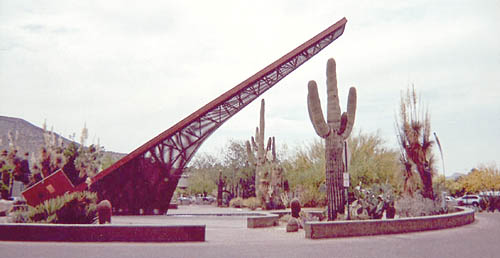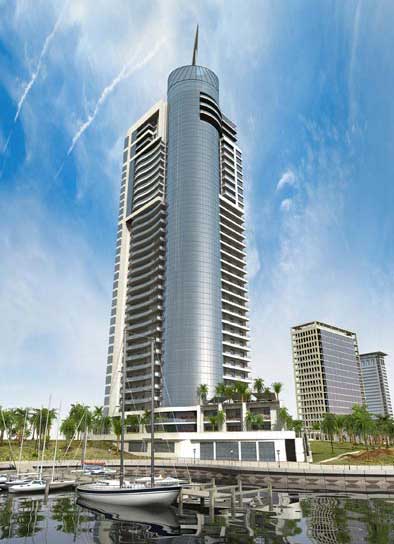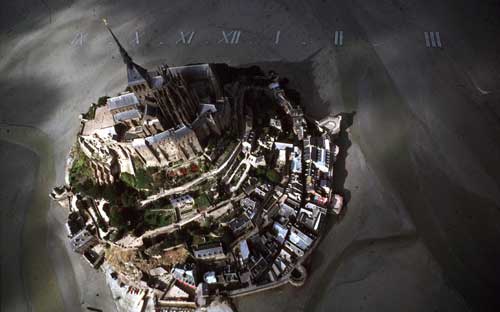Washington Monument as Sundial
Artist Yuri Schwebler turns the Washington Monument into a sundial in the snow, c. 1974. Thanks to Natalie Campbell and Kristina Bilonick for the tip!
Artist Yuri Schwebler turns the Washington Monument into a sundial in the snow, c. 1974. Thanks to Natalie Campbell and Kristina Bilonick for the tip!
The Corpus Clock was invented and designed by Dr John Taylor who brought together in its creation an exception team of craftsmen, engineers and skilled technicians. The clock’s face is a rippling gold disc, about 5 feet diameter, and displays the time by opening individual slits in the clock face backlit with blue LEDs instead of hands.
The dominating feature of the clock is a sculpture of a devouring metal insect which looks like a grasshopper or locust. The sculpture is actually the clock’s escapement. Taylor calls this beast the Chronophage (literally “time eater”, from the Greek). It moves its mouth, appearing to “eat up” the seconds as they pass, and occasionally it “blinks”. The creature’s constant motion produces an eerie grinding sound that suits its task. The hour is tolled by the sound of a chain clanking into a small wooden coffin hidden in the back of the clock.
Below the clock is an inscription mundus transit et concupiscentia eius (“the world passeth away, and the lust thereof”).
Conceived as a work of public art, the Chronophage reminds viewers in a dramatic way of the inevitable passing of time. Taylor deliberately designed it to be “terrifying”: “Basically I view time as not on your side. He’ll eat up every minute of your life, and as soon as one has gone he’s salivating for the next.” Others have described it as “hypnotically beautiful and deeply disturbing”.
More info: YouTube video explaining clock, chronophage website, and conspiracy theorists.
Another contender for largest sundial in the western hemisphere—the sundial in Carefree, Arizona. It was built in 1959 in honor of K.T. Palmer, the founder of the town, and is 72 feet long and 35 feet high. More info here and here.

Another contender for the world’s biggest sundial today is in the Torne Valley, north of the Arctic Circle. It is 38.33 m. in diameter and is situated at 23.28
The Basilica of San Petronio is the main church of Bologna, the old città d’arte in the Emilia Romagna region of Italy. The church hosts also a sundial in the form of a meridian line inlaid in the paving of the left aisle in 1655; it was calculated and designed by the famous astronomer Giovanni Domenico Cassini, who was teaching astronomy at the University: at 66.8 meters it is the longest sundial in the world, following measurements that were for the time uniquely precise.
The video below shows the passage of the sun on the Cassini’s meridian line inside San Petronio in Bologna on the 30th November 2007. Thanks to matutianu1935 of YouTube-
TIMEPLACE Tower, Dubai: 35 storeys, 158m + 40m sundial
Timeplace incorporates a huge sundial on top of the skyscraper so that the sundial’s shadow falls across the building’s cylindrical shape, allowing the time to be seen from miles away and from everywhere within the Marina.


Edward Leedskalin moved to Florida in around 1919 and proceeded to single-handedly build a massive coral monument, which is now a tourist attraction known as Coral Castle (and which has a sundial within it). No one knows exactly how he managed quarrying, moving and sculpting over 1000 tons of coral by himself–when asked, Leedskalin gave vauge and cryptic answers. He wrote a few pamplets, some of which described his theories on magnetism, such as how electricity can be stored in a magnetic loop for months (here’s the “code” to some of these ideas).

(thanks to flickr mad short chick for image)
One of the contestants for world’s largest sundial resides in Singleton, Australia–it has various claims for largest in Southern Hemisphere, etc. It was the major feature of the Bicentennial Riverside Park Project. Construction of the Sundial was financed by Lemington Coal Mine, a State Bicentennial Grant and generous contributions from mining, industry and community groups within and around Singleton. More info. And more.
A 48-foot tall sundial painted inside a silo in a country club in Louisa, VA.


In September of 2006 (date may be inexact) the French army installed 600 one meter square reflective panels in the shape of Roman numerals on the sands of Mont Saint-Michel, a small rocky island off the coast of Normandy. The island’s 150-foot abbey spire cast a shadow three quarters of a mile long that swept across the numerals. Wow. Video of the installation, a thorough blog post in English, and the website for the project, in French.